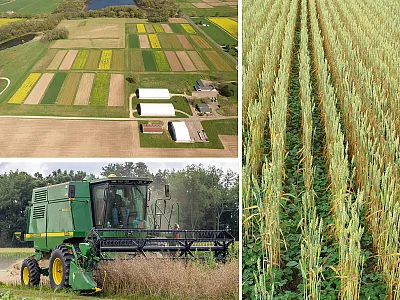Role of Biologicals in Enhancing Nutrient Efficiency in Corn and Soybean
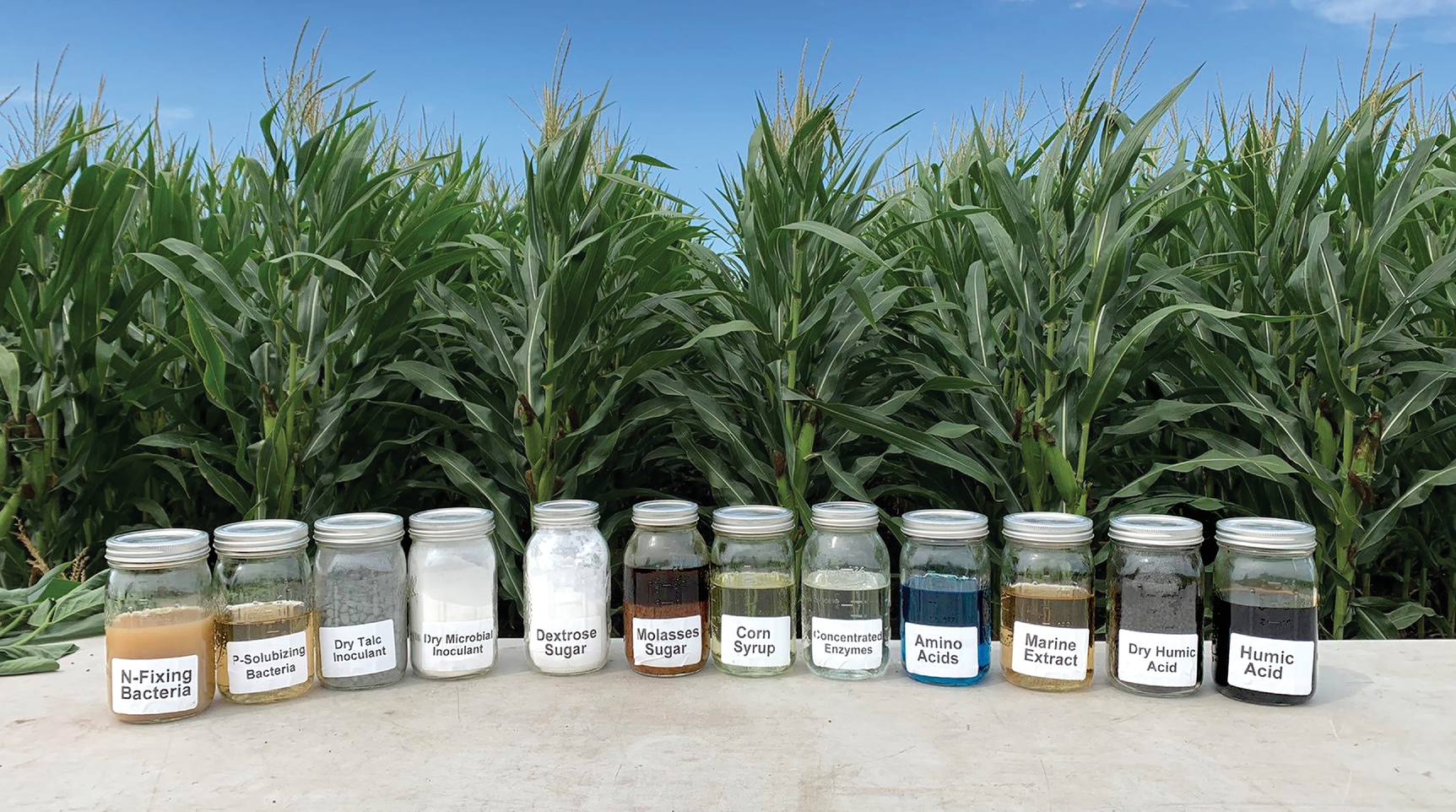

National, state, and regional corn and soybean yields continue to set new production records, and with and these higher yields come a larger nutrient requirement per land area. Improvements in fertilizer use efficiency are needed to sustain high yields while mitigating off-target nutrient movement. Are biologicals the key? There has been a surge of biological products coming to market with claims to enhance soil nutrient supply and/or improve fertilizer use efficiency. However, not all products are created equal, and each performs in a unique way, resulting in questions of which product types work, where and how they work, and most importantly, what other management practices help realize the full economic benefit of these biological products. Earn 1 CEU in Nutrient Management by reading this article and taking the quiz.
National, state, and regional corn and soybean yields continue to set new production records, and these higher yields are essential to meet the global food production needs of a growing population. With higher yields come a larger nutrient requirement per land area, and the use of fertilizers is critical to maintain soil nutrient supply. However, the efficiency of fertilizer use (defined as the percent of the applied nutrient used by that season’s crop) is typically low, particularly for nitrogen (N) and phosphorus (P), and improvements are needed to sustain high yields while mitigating off‐target nutrient movement. Are biologicals the key?
There has been a surge of biological products coming to market with claims to enhance soil nutrient supply and/or improve fertilizer use efficiency. However, not all products are created equal, and each performs in a unique way, resulting in questions of which product types work, where and how they work, and most importantly, what other management practices help realize the full economic benefit of these biological products.
Ensuring Crop Nutrient Availability With Fertilizer
There are 17 essential nutrients for plant growth and development. Carbon, hydrogen, and oxygen are supplied from water and the atmosphere, and the 14 mineral nutrients are supplied by the soil and supplemented with fertilizers. The three macronutrients of nitrogen (N), phosphorus (P), and potassium (K) make up the majority of fertilizer applications to corn and soybean (and other row crops) as they are required in the greatest amounts (Table 1).
| Nutrient | Corn (230 bu) | Soybean (60 bu) | Two-crop total |
|---|---|---|---|
maximum total uptake (lb/ac) | |||
| N | 256 | 245 | 501 |
| P2O5 | 101 | 43 | 144 |
| K2O | 180 | 141 | 321 |
removed with the grain | |||
| N | 148 | 179 | 327 |
| P2O5 | 80 | 35 | 115 |
| K2O | 59 | 70 | 129 |
aData adapted from Bender et al. (2013 and 2015).
A clear problem associated with N fertilizers is the multiple mechanisms that can lead to N loss, and as a result, lower availability for crop uptake and lower fertilizer use efficiency. Nitrogen can be lost from the soil system through leaching (downward movement of nitrate‐N with water into the subsoil), denitrification (gaseous loss to the atmosphere under waterlogged conditions), or volatilization (loss of ammonia‐N as a gas into the atmosphere). Therefore, when N is applied as a fertilizer, it cannot be guaranteed that 100% will be present at the time of crop uptake, which for corn, has a peak uptake rate of 7 lb N/ac/day for approximately 21 days (Figure 1). While there are fertilizer additives like nitrification or urease inhibitors that slow the rate of N loss, and can help to time nutrient release with crop uptake, there are still opportunities for improvement like new biologically derived sources of N that may be less susceptible to loss.
Phosphorus fertilizers supply P as the phosphate ion, which is easily complexed with soil cations like aluminum (Al), calcium (Ca), and iron (Fe) to form mineral phosphates or oxides. This absorption of applied P to clay minerals or cations leads to the inherently low uptake efficiency of P fertilizers (on average 15–40%). Phosphorus, however, has the highest harvest index of all the macronutrients with 79% of the total uptake removed with the grain (Figure 1), and this high harvest index along with the low uptake efficiency drives the need for annual applications of P fertilizers.
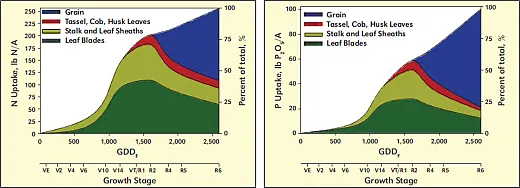
While many of our soils contain enough K to supply crop needs, the properties of the soil bind K tightly, and its availability for the crop during peak uptake can be limited. Thus, like P, the application of K fertilizers is needed to ensure there is enough plant‐available K when the crop needs it.
For these reasons, N, P, and K fertilizers are typically applied at full rates in each season to ensure that crops have the available nutrition to meet yield demand as well as to maintain soil nutrient levels for future crops. This fertilization need stems from the concept of Liebig’s Law of the Minimum where maximum yield potential is limited by the nutrient with the lowest availability for crop uptake. However, these annual fertilizer applications can sometimes result in excess N or a buildup of P in soils, which can lead to off‐target movement to water systems.
New technologies have been coming to the marketplace labeled as “nutrient efficiency” products—commonly referred to as biologicals, biostimulants, or biocatalysts—with claims to enhance soil nutrient supply and/or improve fertilizer use efficiency. This shifts the traditional approach of “apply enough fertilizer to ensure the crop has what is necessary to meet yield expectations” to “manage our fertilizer applications to ensure the applied nutrition is available as the crop needs it.” Rather than apply all fertilizer and hope it is still available for the duration of the season, can we manage the nutrients to become available as the crop develops?
There are many different categories of these biological nutrient efficiency technologies represented by hundreds of individual products, leading to confusion and skepticism as to their efficacy and ability to improve nutrient use efficiency. To understand the best approach for the use of a nutrient efficiency product, one must start with knowledge of the types of products, or categories, that exist and how that category works.
Categories of Biological/Biostimulant Products
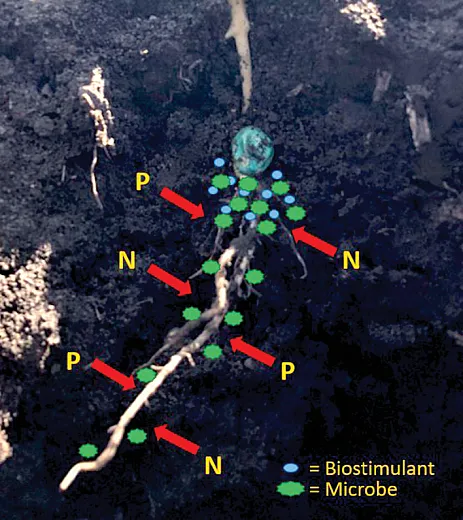
Biologicals or biostimulants are common terms that are used to represent a wide array of specialty products available to growers, and while these umbrella terms are used for many different products, it is key to remember that these technologies are all unique from each other. This is similar to when one uses the term “fertilizer” to represent all nutrient inputs even though fertilizers differ in the nutrients supplied, the percentages of nutrients within the product, and the rate of nutrient release. Nutrient efficiency products can also be categorized in different ways, including: (1) their active ingredient, (2) the nutrient that they impact, (3) their mechanism of action, (4) how they’re applied, and others. Most of these products can be grouped as living beneficial microorganisms or non‐living biostimulants. As most products in the biostimulant category are targeted for in‐season mitigation of crop stress, the remainder of this article will focus on the beneficial microorganisms related to improving crop nutrition.
Beneficial Microbes
Beneficial microbes refer to the products that contain living microorganisms of bacteria or fungi, and the active ingredient of these products is the species contained within the inoculum being applied. An organism is identified in italic by its genus and species. Some microbial species are further identified with a specific strain, and occasionally this will also be listed on the product label. This is important because the beneficial microbes in the context of this article are distinct from biopesticides in which the active ingredient can also be a microorganism. The bacteria Bacillus subtilis is one example where some strains are found in nutrient efficiency products while in others (like the strain MBI 600), they are classified as a biofungicide. The concept of applying a living microbe to an agronomic system is not new as inoculants have been on the market for decades that directly associate with legume plants, such as Bradyrhizobium spp. for soybean. What is new, however, are inoculants that target the soil in the root zone to enhance nutrient cycling, earning their namesake of nutrient efficiency products.
With so many products on the market representing a wide variety of species and strains, it is important for growers to do some background research into the exact microbial species they are purchasing to understand how it functions and to know if such a microbial product is necessary on their farm. Most of these products can be classified into four major groups: (1) nitrogen‐fixing bacteria, (2) phosphorus‐solubilizing bacteria or fungi, (3) rhizosphere stimulation and residue decomposition, and (4) arbuscular mycorrhizal fungi (AMF).
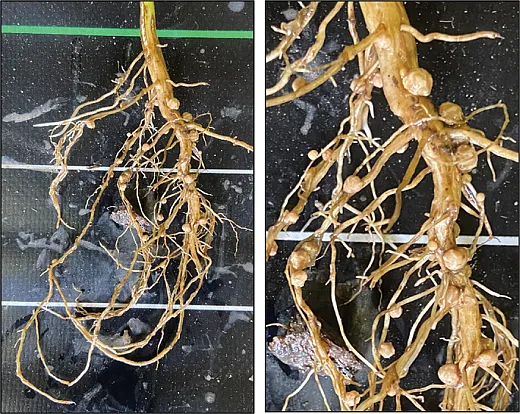
The concept of N‐fixing bacteria inoculation is well known, and most growers are familiar with the symbiotic association between Bradyrhizobium and soybean that leads to nodule formation (Figure 2). What has changed is the discovery of soil microbes that can fix N in the rhizosphere of grass crops like corn, wheat, or sorghum. Rather than developing nodules, these bacteria live along the root and feed on the root exudates. Products containing these microbes are marketed with the promise of providing plants with N, thereby allowing for a significant reduction (20% or more) in the need for fertilizer N inputs. These claims, however, are hard to prove, as most corn growers tend to apply excess “insurance” N, and as such, it is likely that many systems could reduce total N inputs by 5–15% (10–30 lb N/ac) and not see a yield loss.
Figure 2 Soybean root with Bradyrhizobium nodules. Left, whole root at V6 growth stage; right, closer view of nodules.
Where we believe these N‐fixing microbes can make a difference is in those areas of the field where N is insufficient due to either limited soil mineralization or due to loss of the fertilizer N from leaching or volatilization. Thus, this biologically derived N effectively acts as an additional source of N for the crop and a source that may be less susceptible to loss. The lower loss potential is because these microbes produce NH4, which does not leach and is made right in the root zone, enhancing the potential for immediate crop uptake. While use of these products would not directly increase the efficiency of fertilizer‐applied N, it could provide enough peace of mind to eliminate excess applications of insurance N and allow for a 5–15% reduction in the current N rates without risking a yield loss. Optimistically, new and better versions of these products are likely to come to market that will allow for higher rates of N fertilizer reductions with less risk of yield loss.
Phosphorus solubilization by bacteria or fungi is also not a novel idea as microbes have been doing this in our soils since their existence. It is important to note, however, that solubilization of P is different from mineralization of soil P; microbes that solubilize P release inorganic P back into the soil solution while microbial mineralization is the enzymatic release of organic nutrients. Advancements in the techniques and understanding of soil microbiology have allowed for the identification of those microbes that are the most efficient at both processes and the ability to culture them and then to apply them as a concentrated soil inoculant. Most microbes solubilize P to a certain extent, but there are some species that are particularly effective, including: Aspergillus and Penicillium fungi and Bacillus, Pseudomonas, and Rhizobium bacteria.
Alternatively, those bacteria that are classified as rhizosphere stimulation and residue decomposition fit into the mineralization strategy. These microbes are efficient at producing enzymes and other metabolites that help benefit the entire soil system by stimulating native microbes into action to help cycle organic matter and stimulate root growth and development. These microbes are of particular interest in managing high‐residue rotations such as cover crops, double crops, or continuous corn.
What is important to note when working with applied microorganisms is that just like a crop requires adequate nutrition, so do the microbes! The microbes themselves can only get so far, and it is incorporation of these microbes into a management program that provides the best benefit as observed in our research to improve yields of continuous corn (Table 2).
| Fall management | Yield (bu/ac) | Δ Yield |
|---|---|---|
----------------------- bu/ac ----------------------- | ||
| Long-term continuous corn | 153 | – |
| Broadcast Bacillus blend | 158 | + 5 |
| Ammonium sulfate | 162 | + 9 |
| Bacillus + AMS | 163 | + 10 |
| Sized residue | 166* | + 13* |
| Bacillus + sized residue | 166* | + 13* |
| AMS + sized residue | 167* | + 14* |
| Bacillus + AMS + sized residue | 178* | + 25* |
*Significant at the .05 probability level compared with the unmanaged long‐term continuous corn yield of 153 bu/ac.
Common microbes in these types of products are Azospirillum brasilense, Bacillus amyloliquefaciens, Bacillus licheniformis, and Bacillus megaterium. The key to the microbes in either the P solubilization or the residue‐cycling categories is that they accelerate soil nutrient release and do not directly act on the applied fertilizer. However, in the case of P fertility, our research has shown that P‐solubilizing microbes can also indirectly enhance the efficiency of P fertilizers. This is because microbes solubilize P by secreting weak organic acids that chelate cations like Ca and Al, separating them from the inorganic phosphate and making it plant available. While these organic acids facilitate the release soil P, the chelation of those cations also prevents them from binding with applied P fertilizer, keeping it available for crop uptake and increasing its efficiency. A two‐year replicated study comparing in‐furrow applications of P‐solubilizing microorganisms shows this effect where the combination of a biologicals with starter fertilizer was able to increase yields when compared with either product applied alone (Figure 3).
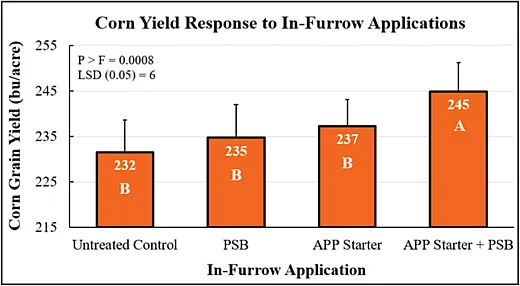
The last group of beneficial microbes is the AMF, which are found naturally in soils and associate in a symbiotic relationship with plants. The AMF are unique in that they form a large hyphae network throughout the soil profile that in essence expands the crops’ root system. As it relates to improving fertilizer efficiency, a greater exploration of the soil profile gives plants a better chance to intercept the applied nutrition for uptake through the AMF network. This network can be particularly important for P, which is relatively immobile in soils.
Conclusions
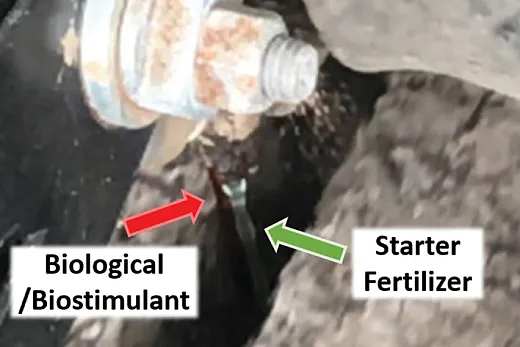
While biologicals and biostimulants are common terms associated with these products, there is quite a wide range in products that fit the lines of “nutrient‐enhancing” technologies. This range provides many different opportunities for their use in agronomic systems, but to realize the full value of these products, it is essential to understand how they work to best integrate them successfully to achieve a return on investment. Most of these microbial solutions work to release nutrients from the soil, increasing plant‐available nutrition in the soil solution. While this release can replace some fertilizer needs in the short term, one must be cautious of the long‐term implications to ensure that we do not mine the soil of that nutrition. Rather, think of these products as helping to cycle the nutrients in the soil more efficiently to increase availability for crop uptake during the growing season.
For N, the challenge of efficiency is the possibility that the applied fertilizer is no longer present due to environmental losses. Therefore, the use of bacterial inoculants for N fixation is to supplement N where it was lost or provide comfort in reducing the 5–15% “insurance” N many growers apply. Conversely, the low efficiency of P fertilizers is due to their being unavailable for crop uptake and not because of nutrient movement from where it was applied. This is where the use of biologicals/biostimulants can benefit fertilizer P efficiency, by upregulating the turnover of that P in the soil solution for better crop uptake. Before introducing any of these new products into their system, growers should consider what specifically they hope to change about their production practices with the new product, and then go and find the right product to fit that need.
References
Bender, R.R., Haegele, J.W., Ruffo, M.L., & Below, F.E. (2015). Nutrient uptake, partitioning, and remobilization in modern soybean varieties. Agronomy Journal, 107, 563–573.
Bender, R.R., Haegele, J.W., Ruffo, M.L. & Below, F.E. (2013). Nutrient uptake, partitioning, and remobilization in modern, transgenic insect‐protected maize hybrids. Agronomy Journal, 105, 161–170.
Self-Study CEU Quiz
Earn 1 CEU in Nutrient Management by taking the quiz. For your convenience, the quiz is printed below. The CEU can be purchased individually, or you can access as part of your Online Classroom Subscription.
- Which nutrient is required by corn and soybean in the greatest amount?
- Nitrogen
- Phosphorus
- Potassium
- Sulfur
- Which nutrient has the highest harvest index of both corn and soybean?
- Nitrogen
- Phosphorus
- Potassium
- Sulfur
- Which process is NOT a direct mechanism of N loss?
- Leaching
- Denitrification
- Volatilization
- N fixation
- What is the nitrogen harvest index of a 230-bu corn crop?
- 45.6%
- 57.8%
- 64.3%
- 79.2%
- Mineralization and solubilization are the same in the context of soil P.
- True
- False
- Phosphorus-solubilizing microorganisms release inorganic phosphates by secretion of weak organic acids.
- True
- False
- Nitrogen-fixing microorganisms for grass crops associate with roots via nodulation, similar to a legume crop.
- True
- False
- Microbial species can have strains with different mechanisms of action.
- True
- False
- Which microbes did the article point out as being of particular interest in managing high-residue rotations such as cover crops, double crops, or continuous corn?
- Nitrogen-fixing bacteria
- Phosphorus-solubilizing bacteria or fungi
- Rhizosphere stimulation and residue decomposition bacteria
- Arbuscular mycorrhizal fungi (AMF)
- Between which growth stages does corn have the greatest rate (lb/ac/day) of N assimilation?
- VE–V4
- V5–V7
- V8–VT
- R1–R6
Text © . The authors. CC BY-NC-ND 4.0. Except where otherwise noted, images are subject to copyright. Any reuse without express permission from the copyright owner is prohibited.






